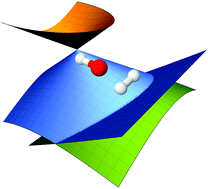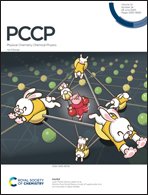On the nonadiabatic collisional quenching of OH(A) by H2: a four coupled quasi-diabatic state description†
Abstract
A four-state diabatic potential energy matrix (DPEM), Hd, for the description of the nonadiabatic quenching of OH(A2Σ+) by collisions with H2 is reported. The DPEM is constructed as a fit to adiabatic energies, energy gradients, and derivative couplings obtained exclusively from multireference configuration interaction wave functions. A four-adiabatic-electronic-state representation is used in order to describe all energetically accessible regions of the nuclear coordinate space. Partial permutation-inversion symmetry is incorporated into the representation. The fit is based on electronic structure data at 42 882 points, described by over 1.6 million least squares equations with a root mean square (mean unsigned) error of 178(83) cm−1. Comparison of ab initio and Hd determined minima, saddle points, and energy minimized points on C2v, Cs, C∞v, and C1 (noncoplanar) portions of two conical intersection seams are used to establish the accuracy of the Hd.

- This article is part of the themed collection: 2020 PCCP HOT Articles


 Please wait while we load your content...
Please wait while we load your content...